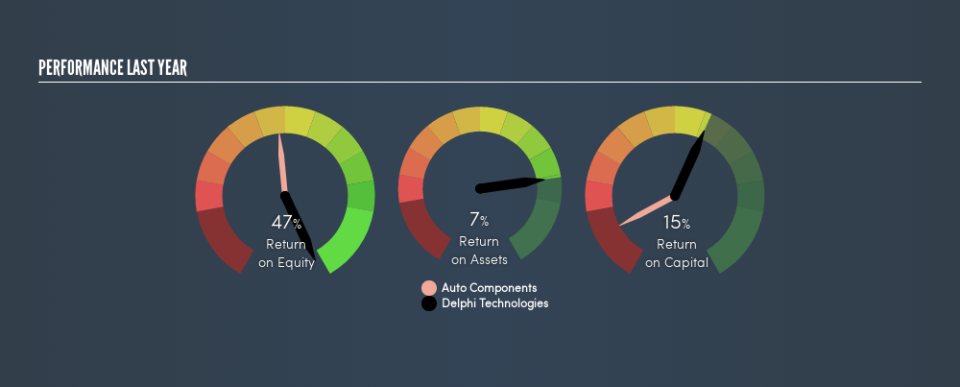Is Delphi Technologies PLC’s (NYSE:DLPH) 15% Return On Capital Employed Good News?

Today we are going to look at Delphi Technologies PLC (NYSE:DLPH) to see whether it might be an attractive investment prospect. To be precise, we'll consider its Return On Capital Employed (ROCE), as that will inform our view of the quality of the business.
First, we'll go over how we calculate ROCE. Second, we'll look at its ROCE compared to similar companies. Then we'll determine how its current liabilities are affecting its ROCE.
Return On Capital Employed (ROCE): What is it?
ROCE measures the amount of pre-tax profits a company can generate from the capital employed in its business. In general, businesses with a higher ROCE are usually better quality. Ultimately, it is a useful but imperfect metric. Author Edwin Whiting says to be careful when comparing the ROCE of different businesses, since 'No two businesses are exactly alike.'
So, How Do We Calculate ROCE?
Analysts use this formula to calculate return on capital employed:
Return on Capital Employed = Earnings Before Interest and Tax (EBIT) ÷ (Total Assets - Current Liabilities)
Or for Delphi Technologies:
0.15 = US$386m ÷ (US$3.9b - US$1.3b) (Based on the trailing twelve months to June 2019.)
Therefore, Delphi Technologies has an ROCE of 15%.
See our latest analysis for Delphi Technologies
Is Delphi Technologies's ROCE Good?
ROCE can be useful when making comparisons, such as between similar companies. Using our data, Delphi Technologies's ROCE appears to be around the 15% average of the Auto Components industry. Regardless of where Delphi Technologies sits next to its industry, its ROCE in absolute terms appears satisfactory, and this company could be worth a closer look.
Delphi Technologies reported an ROCE of 15% -- better than 3 years ago, when the company didn't make a profit. That suggests the business has returned to profitability. The image below shows how Delphi Technologies's ROCE compares to its industry, and you can click it to see more detail on its past growth.
When considering this metric, keep in mind that it is backwards looking, and not necessarily predictive. ROCE can be deceptive for cyclical businesses, as returns can look incredible in boom times, and terribly low in downturns. This is because ROCE only looks at one year, instead of considering returns across a whole cycle. What happens in the future is pretty important for investors, so we have prepared a free report on analyst forecasts for Delphi Technologies.
What Are Current Liabilities, And How Do They Affect Delphi Technologies's ROCE?
Current liabilities include invoices, such as supplier payments, short-term debt, or a tax bill, that need to be paid within 12 months. Due to the way the ROCE equation works, having large bills due in the near term can make it look as though a company has less capital employed, and thus a higher ROCE than usual. To counter this, investors can check if a company has high current liabilities relative to total assets.
Delphi Technologies has total liabilities of US$1.3b and total assets of US$3.9b. Therefore its current liabilities are equivalent to approximately 34% of its total assets. Delphi Technologies has a middling amount of current liabilities, increasing its ROCE somewhat.
The Bottom Line On Delphi Technologies's ROCE
Delphi Technologies's ROCE does look good, but the level of current liabilities also contribute to that. Delphi Technologies shapes up well under this analysis, but it is far from the only business delivering excellent numbers . You might also want to check this free collection of companies delivering excellent earnings growth.
For those who like to find winning investments this free list of growing companies with recent insider purchasing, could be just the ticket.
We aim to bring you long-term focused research analysis driven by fundamental data. Note that our analysis may not factor in the latest price-sensitive company announcements or qualitative material.
If you spot an error that warrants correction, please contact the editor at editorial-team@simplywallst.com. This article by Simply Wall St is general in nature. It does not constitute a recommendation to buy or sell any stock, and does not take account of your objectives, or your financial situation. Simply Wall St has no position in the stocks mentioned. Thank you for reading.

 Yahoo Finance
Yahoo Finance 
